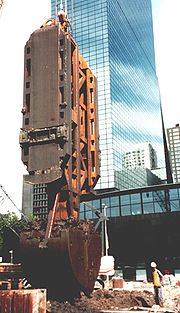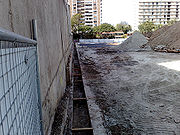
Slurry wall
Encyclopedia


Tunnel
A tunnel is an underground passageway, completely enclosed except for openings for egress, commonly at each end.A tunnel may be for foot or vehicular road traffic, for rail traffic, or for a canal. Some tunnels are aqueducts to supply water for consumption or for hydroelectric stations or are sewers...
s and open cuts, and to lay foundations.
A trench is excavated to create a form for each wall. The trench is kept full of slurry at all times. The slurry prevents the trench from collapsing by providing outward pressure which balances the inward hydraulic forces and prevents water flow into the trench. Reinforcement is then lowered in and the trench is filled with concrete, which displaces the slurry.
Slurry walls are typically constructed by starting with a set of guide walls, typically 1 metre (3.3 ft) deep and 0.5 metre (1.6 ft) thick. The guide walls are constructed on the ground surface to outline the desired slurry trench(es) and guide excavation. Excavation is done using a special clamshell-shaped digger
Excavator
Excavators are heavy construction equipment consisting of a boom, stick, bucket and cab on a rotating platform . The house sits atop an undercarriage with tracks or wheels. A cable-operated excavator uses winches and steel ropes to accomplish the movements. They are a natural progression from the...
or a hydromill trench cutter
Hydromill trench cutter
The hydromill trench cutter is a type of construction equipment designed to dig the wells intended to be used in the casting of slurry walls.- External links :*...
. The excavator digs down to design depth, or bedrock, for the first cut. The excavator is then lifted and moved along the trench guide walls to continue the trench with successive cuts as needed. The trench is kept filled with slurry
Slurry
A slurry is, in general, a thick suspension of solids in a liquid.-Examples of slurries:Examples of slurries include:* Lahars* A mixture of water and cement to form concrete* A mixture of water, gelling agent, and oxidizers used as an explosive...
(usually a mixture of bentonite
Bentonite
Bentonite is an absorbent aluminium phyllosilicate, essentially impure clay consisting mostly of montmorillonite. There are different types of bentonite, each named after the respective dominant element, such as potassium , sodium , calcium , and aluminum . Experts debate a number of nomenclatorial...
and water) at all times to prevent collapse.
Once a particular length is reached, a reinforcing
Rebar
A rebar , also known as reinforcing steel, reinforcement steel, rerod, or a deformed bar, is a common steel bar, and is commonly used as a tensioning device in reinforced concrete and reinforced masonry structures holding the concrete in compression...
cage is lowered into the slurry-filled pit and the pit is filled with concrete
Concrete
Concrete is a composite construction material, composed of cement and other cementitious materials such as fly ash and slag cement, aggregate , water and chemical admixtures.The word concrete comes from the Latin word...
from the bottom up using tremie
Tremie
In the Tremie Concrete method, concrete is placed below water level through a pipe, the lower end of which is kept immersed in fresh concrete so that the rising concrete from the bottom displaces the water without washing out the cement content....
pipes. The concrete displaces the bentonite slurry, which is pumped out and recycled.
Slurry walls are built to enclose the desired area, blocking water and softened earth from flowing into it. On completion of concreting, digging within the now concrete wall-enclosed area can proceed. To prevent the concrete wall from collapsing into the newly open area, temporary supports such as tieback
Tieback (geotechnical)
A tieback is a horizontal wire or rod, or a helical anchor used to reinforce retaining walls for stability. With one end of the tieback secured to the wall, the other end is anchored to a stable structure, such as a concrete deadman which has been driven into the ground or anchored into earth with...
s are installed. When completed, the structure built within the walled-off area supports the wall, so that tiebacks and/or other temporary bracing may be removed.
Slurry wall construction was used to construct the "bathtub"
The Bathtub
"The Bathtub" refers to the underground foundation area at the site of the World Trade Center and accompanying buildings in New York City. Despite its title, it does not hold any water, rather it keeps water out and acts as a bathtub in reverse....
that surrounded most of the World Trade Center site
World Trade Center site
The World Trade Center site , also known as "Ground Zero" after the September 11 attacks, sits on in Lower Manhattan in New York City...
. Slurry walls were also used heavily in Boston's Big Dig tunnel project.
External links
- Video Overview of Slurry Wall Construction
- WTC-slurry wall construction-1967
- Slurry Trenches
- Video of slurry wall construction
- A technical resource for slurry wall construction, slurry trenches and cut-off walls
- Natural shale appears to be ideal material for landfill liners
- Barrier technologies for environmental management
- Pictures of slurry mixers and equipment
- Pictures of slurry walls

